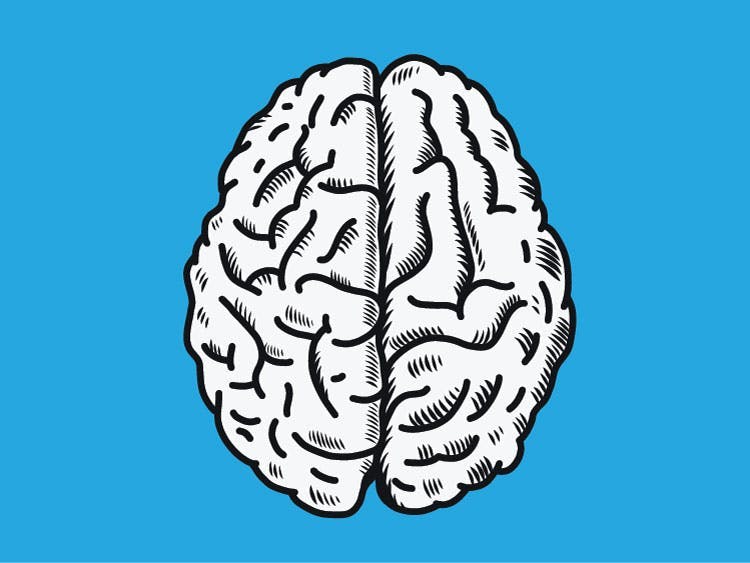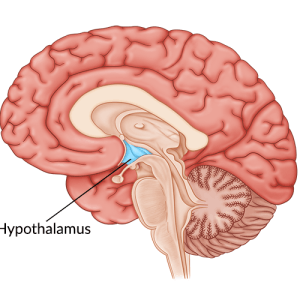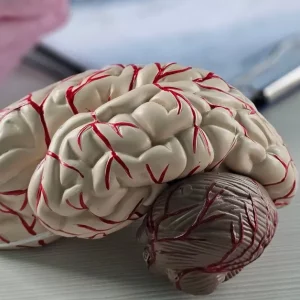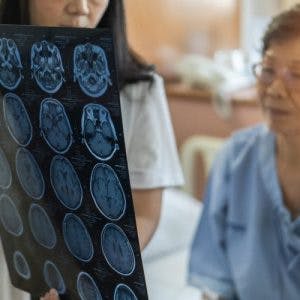Left side brain damage can lead to difficulties with language and reasoning skills, among other secondary effects. Understanding the potential effects of left hemisphere brain damage can help you quickly identify complications and seek early management interventions to maximize your outcome.
To help you understand what to expect following injury to the left side of the brain, this article will discuss:
Functions of the Left Hemisphere
To understand what to expect following left side brain damage, it helps to first review how the brain works. The brain acts as the control center for the entire body and is responsible for both physical and cognitive functions.
The brain is divided into two sides, or hemispheres, which are distinguished as left and right. Each hemisphere is responsible for governing function on the opposite side of the body. For example, the left side of the brain commands movement on the right side of the body, and vice versa.
In addition to movement control, the right side of the brain is largely responsible for non-verbal, intuitive, and creative actions such as musical and artistic abilities. On the other hand, the left side of the brain is primarily in charge of regulating verbal, analytical, and logical functions.
Some primary functions controlled by the left side of the brain include:
- Logic and reasoning
- Number skills
- Analytic thought
- Language comprehension and speech
- Right-side body movements
- Sequential thinking
The left side of the brain is considered the “language hub” of the brain. It is where the bulk of your language abilities lie, particularly your ability to produce and understand language. Consequently, damage to the left hemisphere can result in a variety of speech- and language-related deficits.
Now that you’re familiar with what functions are regulated by the left side of the brain, let’s discuss the potential effects of left side brain damage. Keep in mind that everyone’s brain is uniquely wired and the different areas of function will vary slightly from person to person.
Left Side Brain Damage Symptoms
Damage to the left side of the brain can occur due to many different neurological injuries or disorders, including TBI and left hemisphere stroke. Depending on the location of the injury, left side brain damage can cause a variety of secondary effects that impact your movement, communication, and cognitive skills.
Below are some common effects that may occur following left side brain damage:
1. Aphasia
Aphasia is a language disorder that affects a person’s ability to produce and understand speech. It may also cause difficulties with reading and writing, which can be extremely frustrating for survivors.
Several types of aphasia may develop after damage to the left side of the brain. The three most common are:
- Broca’s aphasia. This is sometimes referred to as “expressive” or “non-fluent” aphasia. With Broca’s aphasia, a person may understand what others say, but cannot produce their own words. As a result, they may struggle to find the right words to say and might repeatedly use short sentences or single words to get their point across. Individuals with Broca’s aphasia are often able to read (silently, not out loud), but frequently have trouble with writing.
- Wernicke’s aphasia. This form of aphasia is the opposite of Broca’s aphasia. With Wernicke’s aphasia, a person can speak fluently, but cannot understand language. For example, they may be unable to read or recognize what others are saying, and often speak in long, nonsensical sentences. The tone and articulation of their words may be unaffected, but these individuals tend to speak rapidly and might have difficulty repeating words or phrases.
- Global aphasia. This is considered to be the most severe form of aphasia as it affects multiple language hubs in the brain, including Broca’s and Wernicke’s areas. A person with global aphasia cannot speak, read, or write and may only minimally understand others.
2. Apraxia of Speech
Not all language problems are caused by aphasia. Following left side brain damage, the brain sometimes loses its ability to communicate fluently with the facial muscles. This leads to a condition called apraxia of speech, or verbal apraxia.
With apraxia of speech, the brain cannot plan and coordinate the sequences of oral motor movements necessary for speech articulation. This may make it difficult to form and pronounce words correctly, even though you may not have weakness in the muscles involved in speech and you know what words you want to say.
3. Dysarthria and Dysphagia
Two other speech disorders associated with left side brain injury are dysarthria and dysphagia. Dysarthria refers to a weakness of the mouth and tongue, which causes a person to speak more slowly and/or slur their speech. On the other hand, dysphagia refers to difficulty swallowing due to weakness or impaired control of the throat muscles used for swallowing.
The two disorders often appear together because speaking requires many of the same muscles used for swallowing. If left untreated, dysphagia can lead to serious complications such as choking, pneumonia, and malnutrition, so it is important to seek help from your rehab team.
4. Right-Side Weakness (Hemiparesis) and Sensory Loss
The left side of the brain controls movement on the right side of the body, therefore left side brain damage may cause right-side weakness (hemiparesis). In severe cases, a person can experience full paralysis on their right side (right sided hemiplegia).
These conditions occur because of damage to the primary motor cortex, which lies in the frontal lobe of the brain. If the left half of the motor cortex sustains damage, movement on the right side of the body will be affected.
After damage to the left motor cortex, a person may struggle to:
- Lift their right arm
- Move the fingers on their right hand
- Control the right side of their face
- Walk due to balance difficulties and weakness of the right leg
In addition, if left side brain injury includes damage to the internal capsule or somatosensory cortex, survivors may experience a loss of sensation on their right side. This can manifest as numbness, tingling, pins-and-needles, a loss of proprioception, and other sensory deficits.
To restore movement, you should practice physical therapy exercises that utilize your affected muscles. This will stimulate the brain and promote adaptive changes to its neural pathways. Furthermore, another therapy technique called sensory reeducation can be used to help regain sensation after left side brain injury, such as stroke.
5. Computation and Reasoning Problems
Lastly, left side brain damage may cause difficulties with math and logic skills. It may also affect abstract reasoning and organization abilities. Individuals with left hemisphere damage often struggle to keep their thoughts straight, which may make problem-solving more difficult and lead to increased frustration.
Some other cognitive skills that left side brain injuries can affect include:
- Concentration
- Memory
- Ability to gather and sort information
- Prioritization
- Strategy and planning
These skills help comprise a group of abilities known as executive functions. To help you understand how to recover these functions, as well as others affected by left side brain damage, the following section will discuss treatment options.
Left Side Brain Damage Treatment
While the effects of left side brain damage can be serious, they may not be permanent. The brain possesses a remarkable ability to make adaptive changes, known as neuroplasticity. This ability enables the brain to rewire functions affected by damage to unaffected regions of the brain, allowing for relearning of lost skills.
To activate neuroplasticity, you must engage in highly repetitive and intensive practice of affected movements or skills. This helps stimulate the brain and reinforce demand for those functions.
Some rehabilitative therapies that can help you promote neuroplasticity after left side brain damage include:
Speech Therapy
Speech therapy can help individuals overcome aphasia, apraxia, and dysarthria. Additionally, a speech therapist may teach individuals effective practices to develop their cognitive abilities, such as their executive functioning skills. Speech therapists help evaluate the severity of an individual’s orofacial and cognitive impairments and develop personalized rehabilitation plans to improve them.
For individuals with more severe forms of language impairments, a speech therapist may teach them how to use alternative forms of communication to improve their quality of life. Speech therapists can also address dysphagia through oral motor exercises and recommending foods with softer textures as needed.
Physical Therapy
To recover motor control on the right side of the body, individuals should participate in physical therapy after left side brain damage. A physical therapist will guide the individual through targeted exercises to stimulate weakened muscles, improve balance, and promote neuroplasticity in the brain.
Major areas of focus for a physical therapy rehabilitation plan will include increasing range of motion and decreasing spasticity. They can help enhance quality of life by improving performance of necessary skills such as transfers (moving from one surface to another) and independent bed mobility. Physical therapy can also help survivors regain the ability to walk and participate in beloved hobbies, even if this requires some modifications.
Occupational Therapy
Occupational therapy focuses on helping individuals maximize their functional independence. This often involves practicing activities of daily living and educating patients about disability rights, adaptive techniques, and potential risks associated with their condition.
Ultimately, recovery after left side brain damage focuses on highly repetitive, task-specific training that encourages the brain to make adaptive changes. Thousands of repetitions are required to promote neurological changes in the brain. Therefore, it’s essential for individuals to have hope, keep practicing, and trust in the process.
Constraint-Induced Movement Therapy
Constraint-induced movement therapy is a type of physical or occupational therapy that focuses on continuous use of the affected side. For individuals with hemiparesis on their right side, the left side of their body will be constrained to force use of the affected right side. The continuous use of the right side will help stimulate the brain and promote neuroplasticity.
Constraint-induced movement therapy continues to be supported by research as an effective intervention to improve use of an affected limb after neurological injury. This is generally a rather intensive form of therapy and typically focuses on improving affected upper extremity functions and performance of daily tasks.
Understanding Injury to the Left Hemisphere
Left side brain damage can affect a variety of skills including communication, motor function, and executive functions. Often, these skills can be improved by engaging neuroplasticity in the brain. This is accomplished by participating in rehabilitative therapies and practicing consistent repetitions of targeted exercises and activities.
We hope this article helped you understand the potential outcomes of left side brain damage and how to improve affected functions. Through repetition and consistency, all survivors of left side brain damage can improve their skills and abilities, even years after injury.










